Related Research Articles
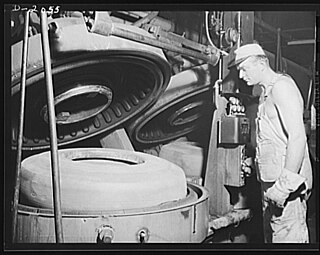
Vulcanization is a range of processes for hardening rubbers. The term originally referred exclusively to the treatment of natural rubber with sulfur, which remains the most common practice. It has also grown to include the hardening of other (synthetic) rubbers via various means. Examples include silicone rubber via room temperature vulcanizing and chloroprene rubber (neoprene) using metal oxides.
![<span class="mw-page-title-main">Silicone</span> Family of polymers of the repeating form [R2Si–O–SiR2]](https://upload.wikimedia.org/wikipedia/commons/thumb/3/37/Caulking.jpg/320px-Caulking.jpg)
In organosilicon and polymer chemistry, a silicone or polysiloxane is a polymer composed of repeating units of siloxane. They are typically colorless oils or rubber-like substances. Silicones are used in sealants, adhesives, lubricants, medicine, cooking utensils, thermal insulation, and electrical insulation. Some common forms include silicone oil, grease, rubber, resin, and caulk.

A thermoplastic, or thermosoftening plastic, is any plastic polymer material that becomes pliable or moldable at a certain elevated temperature and solidifies upon cooling.
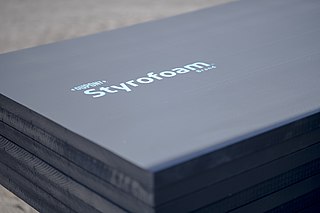
Styrofoam is a trademarked brand of closed-cell extruded polystyrene foam (XPS), manufactured to provide continuous building insulation board used in walls, roofs, and foundations as thermal insulation and as a water barrier. This material is light blue in color and is owned and manufactured by DuPont. DuPont also has produced a line of green and white foam shapes for use in crafts and floral arrangements.
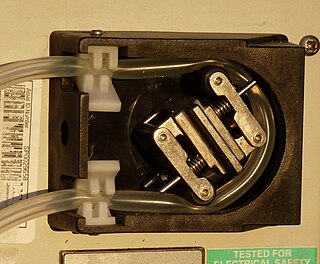
A peristaltic pump, also commonly known as a roller pump, is a type of positive displacement pump used for pumping a variety of fluids. The fluid is contained in a flexible tube fitted inside a circular pump casing. Most peristaltic pumps work through rotary motion, though linear peristaltic pumps have also been made. The rotor has a number of "wipers" or "rollers" attached to its external circumference, which compress the flexible tube as they rotate by. The part of the tube under compression is closed, forcing the fluid to move through the tube. Additionally, as the tube opens to its natural state after the rollers pass, more fluid is drawn into the tube. This process is called peristalsis and is used in many biological systems such as the gastrointestinal tract. Typically, there will be two or more rollers compressing the tube, trapping a body of fluid between them. The body of fluid is transported through the tube, toward the pump outlet. Peristaltic pumps may run continuously, or they may be indexed through partial revolutions to deliver smaller amounts of fluid.
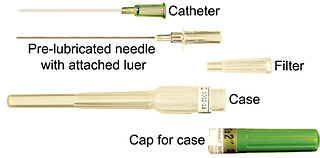
In medicine, a catheter (/ˈkæθətər/) is a thin tube made from medical grade materials serving a broad range of functions. Catheters are medical devices that can be inserted in the body to treat diseases or perform a surgical procedure. Catheters are manufactured for specific applications, such as cardiovascular, urological, gastrointestinal, neurovascular and ophthalmic procedures. The process of inserting a catheter is called catheterization.
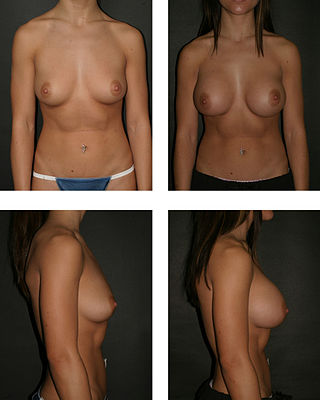
Breast augmentation and augmentation mammoplasty is a cosmetic surgery technique using breast-implants and fat-graft mammoplasty techniques to increase the size, change the shape, and alter the texture of the breasts. Augmentation mammoplasty is applied to correct congenital defects of the breasts and the chest wall. As an elective cosmetic surgery, primary augmentation changes the aesthetics – of size, shape, and texture – of healthy breasts.

An O-ring, also known as a packing or a toric joint, is a mechanical gasket in the shape of a torus; it is a loop of elastomer with a round cross-section, designed to be seated in a groove and compressed during assembly between two or more parts, forming a seal at the interface.

Dow Corning Corporation, was an American multinational corporation headquartered in Midland, Michigan, United States, and was originally established as a joint venture between The Dow Chemical Company and Corning Incorporated. In 2016, Dow bought out Corning, making Dow Corning a 100% Dow subsidiary. After a brief existence as a DowDuPont-owned company, Dow spun out from DowDuPont on April 1, 2019. The new company, Dow Silicones Corporation, which is wholly owned by Dow, specializes in silicone and silicon-based technology, and is the largest silicone product producer in the world.

Heat-shrink tubing is a shrinkable plastic tube used to insulate wires, providing abrasion resistance and environmental protection for stranded and solid wire conductors, connections, joints and terminals in electrical wiring. It can also be used to repair the insulation on wires or to bundle them together, to protect wires or small parts from minor abrasion, and to create cable entry seals, offering environmental sealing protection. Heat-shrink tubing is ordinarily made of polyolefin, which shrinks radially when heated, to between one-half and one-sixth of its diameter.
Silicone rubber is an elastomer composed of silicone—itself a polymer—containing silicon together with carbon, hydrogen, and oxygen. Silicone rubbers are widely used in industry, and there are multiple formulations. Silicone rubbers are often one- or two-part polymers, and may contain fillers to improve properties or reduce cost. Silicone rubber is generally non-reactive, stable, and resistant to extreme environments and temperatures from −55 to 300 °C while still maintaining its useful properties. Due to these properties and its ease of manufacturing and shaping, silicone rubber can be found in a wide variety of products, including voltage line insulators; automotive applications; cooking, baking, and food storage products; apparel such as undergarments, sportswear, and footwear; electronics; medical devices and implants; and in home repair and hardware, in products such as silicone sealants.
Thermoplastic elastomers (TPE), sometimes referred to as thermoplastic rubbers (TPR), are a class of copolymers or a physical mix of polymers that consist of materials with both thermoplastic and elastomeric properties.

A breast implant is a prosthesis used to change the size, shape, and contour of a person's breast. In reconstructive plastic surgery, breast implants can be placed to restore a natural looking breast following a mastectomy, to correct congenital defects and deformities of the chest wall or, cosmetically, to enlarge the appearance of the breast through breast augmentation surgery.
Silicone rubber keypads are used extensively in both consumer and industrial electronic products as a low cost and reliable switching solution.
Thermoplastic vulcanizates (TPV) are dynamically vulcanized alloys consisting mostly of fully cured EPDM rubber particles encapsulated in a polypropylene (PP) matrix. They are part of the thermoplastic elastomer (TPE) family of polymers but are closest in elastomeric properties to EPDM thermoset rubber, combining the characteristics of vulcanized rubber with the processing properties of thermoplastics. There are almost 100 grades in the S portfolio that are used globally in the automotive, household appliance, electrical, construction, and healthcare markets. The name Santoprene was trademarked in 1977 by Monsanto, and the trademark is now owned by Celanese. Similar material is available from Elastron and others.
Medical grade silicones are silicones tested for biocompatibility and are appropriate to be used for medical applications. In the United States, the Food and Drug Administration (FDA) Center for Devices and Radiological Health (CDRH) regulates devices implanted into the body. It does not regulate materials other than certain dental materials. The FDA regulate silicones used in food contact under the auspices of the Center for Food Safety and Nutrition (CFSAN) and for use in pharmaceuticals under the auspices of the Center for Drug Evaluation and Research (CDER).

A tube, or tubing, is a long hollow cylinder used for moving fluids or to protect electrical or optical cables and wires.
Hemlock Semiconductor (HSC) is the largest producer of hyper-pure polysilicon headquartered in the United States. Polycrystalline silicon, also called polysilicon, is a high purity, polycrystalline form of silicon, used as a raw material by the solar photovoltaic and electronics industry.
PharMed®BPT is a polypropylene-based thermoplastic elastomer (TPE) which is opaque beige in color. It remains flexible and stable at temperatures between -40 and 135 °C, and meets the requirements of United States Pharmacopeia Class VI. It has low gas permeability compared to typical silicone materials and can withstand repeated sterilization cycles in an autoclave. It is considered to have a long service life on a peristaltic pump. It is frequently used in medical applications, laboratory applications and single-use pharmaceutical applications. It is manufactured by Saint-Gobain Performance Plastics.

An electrical conduit is a tube used to protect and route electrical wiring in a building or structure. Electrical conduit may be made of metal, plastic, fiber, or fired clay. Most conduit is rigid, but flexible conduit is used for some purposes.
References
- 1 2 United States Patent and Trademark Office, U.S. Trademark 71,503,981 . Filing date June 15, 1946; registration date April 13, 1948. Owner: Dow Corning Corporation, Midland, Michigan 48686-0994.
- ↑ Abdominal Wall Defects by Sajani Shah MD, at M&M Conference at SUNY Downstate Medical Center. Feb 24, 2006.
- ↑ Engel JM, Hichie-Schmidt C, Khammar A, Ostfeld BM, Vyas A, Ticho BH (2007). "Monocanalicular silastic intubation for the initial correction of congenital nasolacrimal duct obstruction". J AAPOS. 11 (2): 183–186. doi:10.1016/j.jaapos.2006.09.009. PMID 17307001.